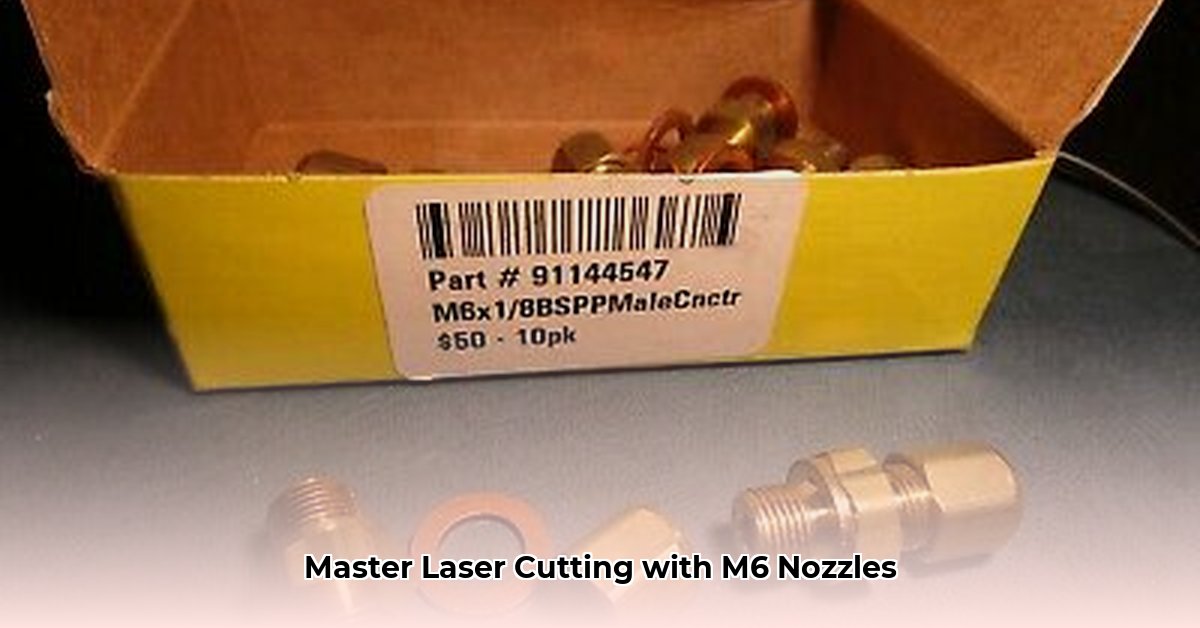
Selecting the Right M6 Tube Nozzle
The M6 tube nozzle is a critical component in laser cutting, directly impacting cut quality and efficiency. Choosing the right nozzle involves careful consideration of several key factors.
Material Selection: A Balancing Act
The nozzle material must withstand the intense heat and abrasive forces of laser cutting. Three common materials offer different trade-offs:
- Sapphire: Offers exceptional heat resistance and durability, ideal for demanding applications. However, it's expensive and can be brittle.
- Ceramic: Provides a good balance of wear resistance and cost-effectiveness, suitable for general-purpose applications. It offers better heat tolerance than brass but less than sapphire.
- Brass: A budget-friendly option, but less durable and more prone to corrosion, requiring more frequent replacements.
The optimal material depends on your specific application and budget constraints. High-precision, high-temperature applications benefit from sapphire, while less demanding tasks may find ceramic sufficient. Brass is best suited for short-term, low-cost applications.
Don't overlook the importance of material compatibility with your laser system and workpiece. Incorrect material pairings can lead to premature wear or damaged components. Always consult your laser system's manual for recommended nozzle materials.
Gas Flow Optimization: Achieving Consistent Cuts
The gas flowing through the nozzle removes molten material, ensuring clean cuts. Finding the right gas flow rate is crucial: insufficient flow results in messy cuts, while excessive flow wastes gas and may damage materials. Your system's manual will provide recommended gas flow rates for various materials and nozzle types. Precise control over gas pressure and flow are key to achieving consistent cut quality.
Laser System Compatibility: Ensuring Seamless Integration
Before purchasing an M6 tube nozzle, verify its compatibility with your laser system. This includes the nozzle's physical dimensions (thread size, length, etc.) and gas delivery mechanism. Using an incompatible nozzle can lead to inefficient operation or damage to your system. Always double-check specifications and consult your laser system's manual.
Installing and Maintaining Your M6 Tube Nozzle
Proper installation and regular maintenance are paramount for optimal performance and longevity.
Installation: A Step-by-Step Process
- Clean the fitting area: Thoroughly clean the laser head fitting area to remove any dust or debris that could interfere with a proper seal. This simple preventative measure prevents leaks and ensures efficient gas flow.
- Securely connect the nozzle: Carefully screw the nozzle onto the laser head, following manufacturer instructions. Over-tightening can damage the threads, leading to leaks. A snug, secure fit is required.
- Test for leaks: After installation, thoroughly inspect the connection for any leaks. Use compressed air to ensure a leak-free seal.
Maintenance: Preserving Performance
- Regular inspection: Frequently inspect the nozzle for signs of wear, such as chipping or cracks. Replace the nozzle if issues are detected early instead of waiting to prevent long-term damage and costly repairs later.
- Cleaning: Regularly clean the nozzle using compressed air to remove residue buildup. Avoid harsh chemicals that could damage the nozzle's surface.
- Replacement: Replace the nozzle immediately at the first signs of wear or if a decline in cutting performance is observed. Proactive replacement saves time and money in the long run.
Troubleshooting Common Issues
Even with proper care, problems can occur.
Clogged Nozzle: Restoring Flow
If the nozzle becomes clogged, try cleaning it with compressed air. Persistent blockages necessitate nozzle replacement.
Inconsistent Cutting Quality: Identifying the Root Cause
Inconsistency often stems from improper gas pressure/flow or nozzle misalignment. Verify that these parameters are correctly set and the nozzle is properly aligned with the laser beam.
Premature Wear: Optimizing Material Selection
Rapid nozzle wear may indicate an unsuitable material for your application. Consider a more durable material like sapphire for harder materials.
Best Practices for M6 Tube Nozzle Optimization
Implementing these best practices enhances performance and extends nozzle lifespan.
- Material Matching: Carefully select a nozzle material compatible with your work materials and cutting parameters.
- Careful Handling: Avoid impacts or dropping the nozzle to preserve its integrity.
- Preventative Maintenance: Regular inspection and cleaning prevents minor issues from escalating into major problems.
By following these guidelines, you'll ensure optimal laser cutting performance and extend the lifespan of your M6 tube nozzles. Remember, proactive maintenance is key to maximizing efficiency and minimizing downtime. Proper nozzle selection and maintenance ensures high-quality, consistent cuts.
Key Takeaways:
- Nozzle selection directly impacts laser cut quality and necessitates careful consideration of material, gas flow, and system compatibility.
- Regular inspection, cleaning, and timely replacement prevent costly downtime and ensure optimal performance.
- A systematic approach to troubleshooting and preventative maintenance can significantly extend nozzle life and enhance efficiency.